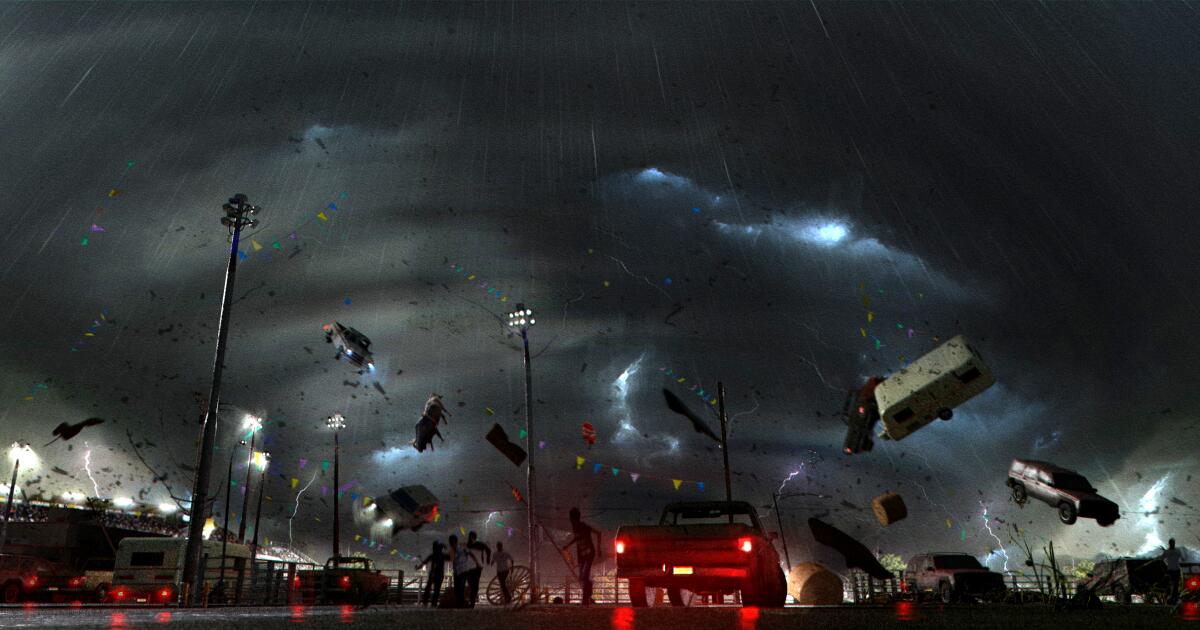Since working on the original “Twister” in 1996, VFX supervisor Ben Snow has earned four Oscar nominations for his contributions to fantastical projects including “Iron Man” and “Star Wars: Episode 2 — Attack of the Clones.” But when he oversaw visual effects for this summer’s hit disaster movie “Twisters” (starring Daisy Edgar-Jones and Glen Powell), that particular F-word never entered the conversation.
Taking his cue from director Lee Isaac Chung, Snow and his Industrial Light & Magic team ditched over-the-top fantasy to make the tornadoes of Oklahoma look as real as possible. “We found that it was better not to push the environment too much,” Snow says. “We talked about possibly doing a surreal yellow, almost postapocalyptic look, but it just had this artificiality that we didn’t like, so we leaned into real photography as a starting point.”
Speaking from his vacation in Kyoto, Japan, Snow talked to The Envelope about teaming with storm chasers and data wranglers to craft the look of havoc-wreaking weather.
These are harrowing times when it comes to extreme weather. How did you use computers to generate such realistic tornadoes?
We sent out storm chasers who actually ran into the weather and shot very high-resolution motion picture footage. That gave us the ability to study tornadoes in a lot more detail than we ever had before. We also had a stills guy, Giles Hancock, who took high-resolution [photo] sets of storm clouds. If we were shooting on a somewhat sunny day, we’d use Giles’ cloudscapes to populate the backgrounds, build out [computer-generated] clouds on top and then the tornado on top of that.
How did you coordinate the division of labor with the special effects team?
I sat down with special effects lead Scott Fisher and we worked out that he would give us the first 60 feet of weather [with practical effects]. They would blow a bit of grass near the car or give us some dust so the crew and the actors had something to react to. The rest of the scene was visual effects. All of the trees along the road, the power poles, we created that in the computer and whipped them around with the wind. The goal was to figure out the battle.
Were you able to essentially sculpt each of the film’s six tornadoes to your liking?
Lee had the desire to make every tornado individual so that each was like a character. If he said to me, “We want to change the tornado to something a bit more like a wedge shape,” the artists understood how to make that change. As the first step, animators made a set of controls so they could basically animate big sculptural shapes of tornadoes around the landscape. Then we’d work out the choreography, and then the particle team would take that information and use very elaborate simulation engines to get the basic path of the tornado and deal with its effect on the environment. We used every trick in the book.
“Twisters” opens with hero Kate (Daisy Edgar-Jones) being traumatized by a ferocious EF-5 tornado blowing at more than 200 miles an hour. How did you approach that from a story point of view?
Tornado 1 is like the shark in “Jaws.” You see it lurking in the cloud, you get glimpses, but we tried to make it mysterious and show this big visceral impact when it hit.
Tornado 4 wreaks havoc on a rodeo and sends a horse trailer flying through the air … real or CG?
The large trailer is there for real. The part where it falls into the pool, that’s computer graphics. Then it goes real for a bit, then it goes to computer graphics again. If the audience sees enough of the real one, that gives us the ability to mix things up.
In the movie’s grand finale, Tornado 6 destroys a factory, catches fire and tears up a movie theater. How did you orchestrate all that intensity?
This tornado had so much going on that when we used our simulation engines, we couldn’t fit it all into memory. We had to break that [sequence] into little bricks of tornado where the tool would simulate one chunk and then tell the next chunk, “This is what happened.” All the adjoining components worked as a continuous result making sure the particles they were simulating went to the right place.
CGI technology has, of course, made quantum leaps since you worked on “Twister” 18 years ago.
One tornado in “Twisters” probably took as much computing power as we used to make the whole of the first “Twister.” It’s crazy. For this one, we had an amazing simulation tool set called ILM Pyro where you can take parameters from a real storm and put them in. The system’s making billions of calculations, almost like what scientists use to map out real weather, but we were doing it to map out simulations to see airflow vectors and that sort of thing.
You invested these weather sequences with six shades of tornado gray that enhance each storm’s villainous vibe. How did you approach the color palette?
With the twin tornadoes, there’s this very distinctive red dirt look that we integrated into the debris field at the base of the tornado. With the EF-5, it’s on grass; we obviously all know what grass looks like so we had a little more license to go, “OK. What is the coolest, scariest-looking tornado that we can find?”

